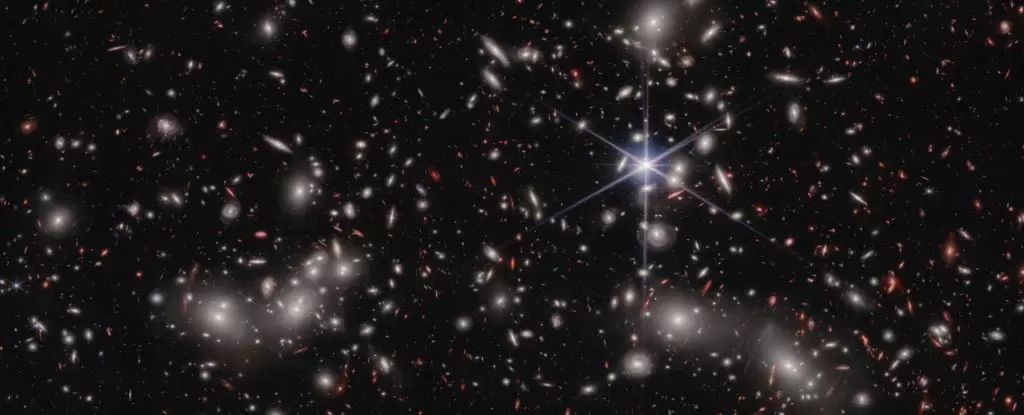In our quest to understand the history of the universe, scientists have recently begun to shed light on one of its most enigmatic epochs: the cosmic dawn. A groundbreaking study published in February 2024 has revealed that small dwarf galaxies played a pivotal role in transforming a dark, formless void into a vibrant cosmos. Utilizing data from the Hubble and James Webb Space Telescopes, this research has shifted our understanding of how the universe evolved during its infancy, challenging prior notions that larger structures were solely responsible for igniting the cosmic fireworks of reionization.
The Role of Ultra-Faint Galaxies
Astrophysicist Iryna Chemerynska of the Institut d’Astrophysique de Paris emphasized the transformative significance of ultra-faint galaxies. These small stellar formations produced ionizing photons, which are crucial in converting neutral hydrogen—plentiful in the early universe—into ionized plasma during the epoch of cosmic reionization. This revelation underscores not only the abundance of these low-mass galaxies but also their critical influence in shaping the universe’s history. As it turns out, these diminutive galaxies are not mere background players; they are the powerhouses responsible for altering the very state of cosmic matter.
From Darkness to Dawn: A Brief History
To grasp the phenomena of cosmic reionization, we first need to understand the nature of the early universe. Following the Big Bang, the cosmos was engulfed in a dense fog of ionized plasma. This early state was so opaque that most photons were unable to penetrate, rendering the universe perpetually dark. However, as the universe cooled, protons and electrons clumped together and formed neutral hydrogen gas—an essential ingredient for stellar formation.
Spanning several hundred thousand years, this neutral hydrogen began to cradle the first stars. It was these nascent stellar bodies that unleashed high-energy radiation, tearing electrons away from their atomic nuclei and effectively reionizing the surrounding gas. Fast forward to approximately one billion years after the Big Bang, and the universe had entered a new phase—no more cosmic fog; the lights were finally on. Yet, understanding how precisely this happened has long eluded astronomers.
Breakthrough Observations with JWST
The scientific landscape changed dramatically with the deployment of the James Webb Space Telescope (JWST), which aimed to delve deeper into the cosmic dawn. Many researchers had assumed that significant contributors to reionization must be colossal black holes or sprawling galaxies in the throes of star formation. However, due to the exceptional capabilities of JWST, a team led by Hakim Atek from the Institut d’Astrophysique de Paris made an astonishing discovery: the tiny dwarf galaxies are indeed the main architects of reionization.
Utilizing the galaxy cluster Abell 2744 as a natural cosmic lens, scientists were able to magnify distant light and observe these elusive dwarf galaxies with unprecedented clarity. Remarkably, their findings showed that these miniature galaxies not only vastly outnumbered larger ones—by an astonishing ratio of 100 to 1—but also generated significantly more ionizing radiation than previously anticipated. This collective power transforms our understanding of the universe’s early evolution.
A Paradigm Shift in Cosmology
The implications of this study are profound. The evidence amassed indicates that dwarf galaxies, often overlooked due to their size, are integral to understanding cosmic reionization. Their immense collective output raises important questions about the nature of galaxy formation and evolution in the early universe. It suggests that the dynamics of low-mass galaxies could have far-reaching consequences for the formation of large structures we observe today.
Despite these promising findings, the research team acknowledges the need for further exploration. Their analysis has primarily focused on a singular patch of the sky, prompting a need for a broader examination to ascertain whether their observations represent the population at large. Future studies will likely utilize JWST’s capabilities to survey additional cosmic lens regions, paving the way for a more comprehensive understanding of early galactic populations.
Venturing into New Frontiers
Astrophysicist Themiya Nanayakkara from Swinburne University of Technology aptly summarizes the excitement surrounding these discoveries: “We have now entered uncharted territory with JWST.” The journey into the cosmic dawn is one of the most tantalizing quests in modern astronomy, and the latest findings signal that we are on the verge of unveiling some of the universe’s most profound secrets. As researchers continue to peel back the layers of time, the stage is set for the further illumination of the universe’s formative years—offering a narrative that is as complex and awe-inspiring as the cosmos itself.

